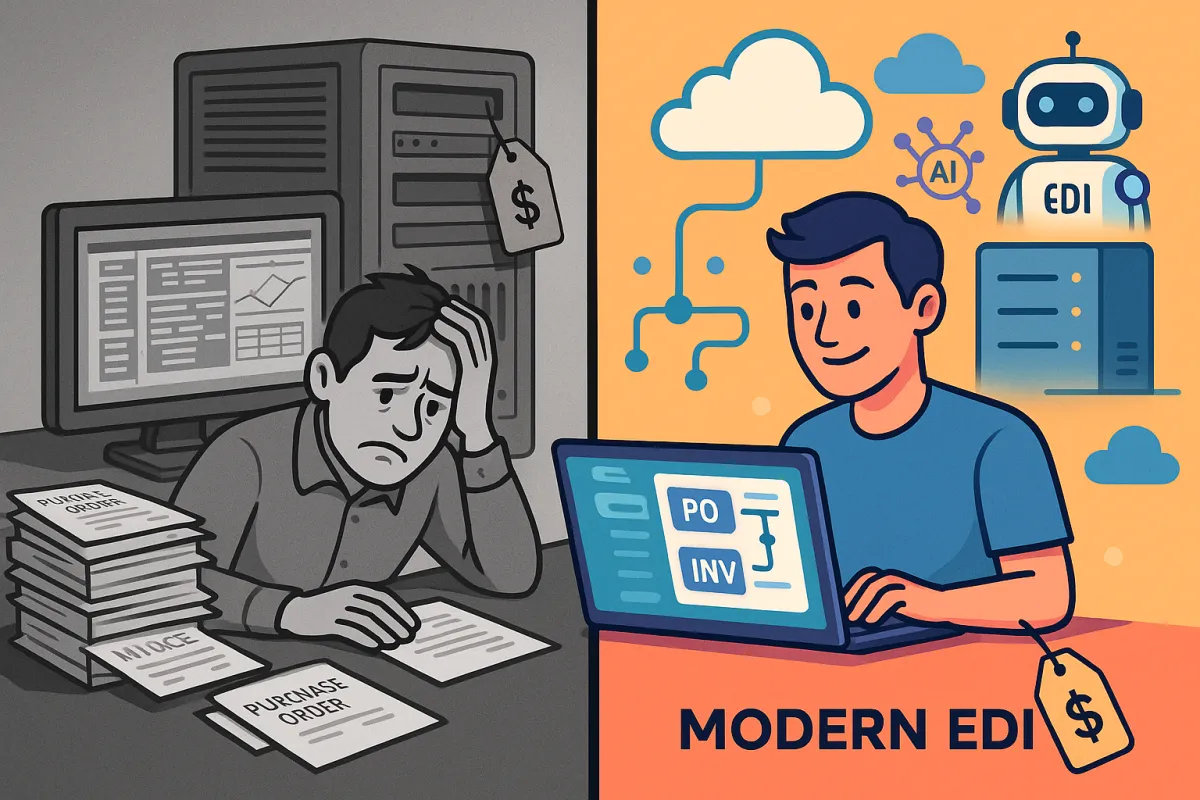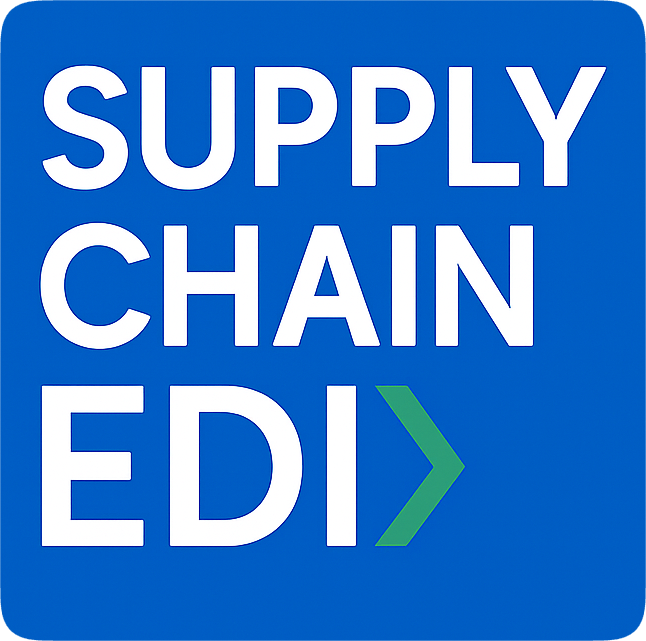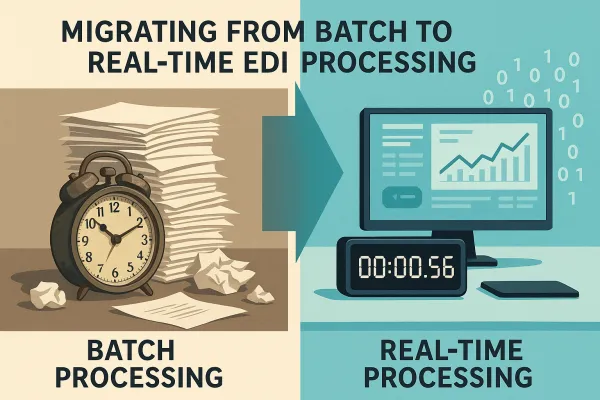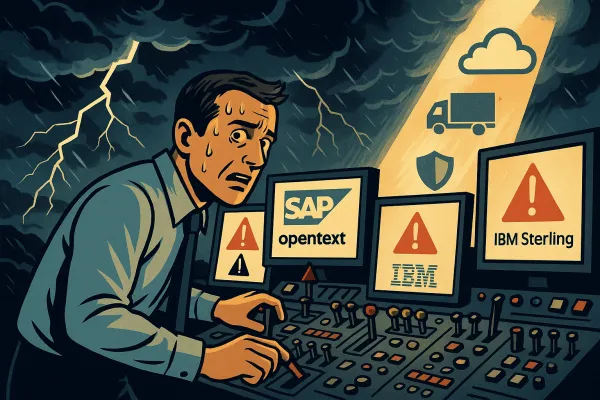The EDI Democratization Revolution: How SMEs Are Breaking Free from Enterprise-Only B2B Integration in 2025

A manufacturer with 200 employees had been manually processing purchase orders from their largest retail partner for years. Every week, their team would spend 12 hours copying order details from email attachments into their ERP system, then manually create shipping confirmations and invoices. The process wasn't just slow—it was expensive. Each hour of manual data entry cost them $35 in labor, plus the hidden costs of delayed orders and occasional keystroke errors that led to chargebacks.
In 2025, Electronic Data Interchange (EDI) has become an essential tool for small and medium businesses (SMBs) looking to stay competitive in an increasingly digital and interconnected world. For SMBs, the ability to automate and streamline data exchange processes is no longer a luxury but a necessity. That manufacturer discovered what thousands of SMEs are learning: the traditional barriers that kept small businesses locked out of efficient B2B integration have crumbled.
The Traditional EDI Barrier: Why SMEs Were Left Behind
For decades, small- and medium-size businesses that simply do not have the people or cannot find the money for this level of investment watched from the sidelines as their larger competitors automated their supply chains. Traditional EDI systems often pose challenges for SMBs, such as high costs, complexity, and limited flexibility.
The numbers tell the story. A significant 56% of respondents pointed to "initial cost" as the primary obstacle of implementing EDI. The initial investment for purchasing software licenses can be substantial, which may pose a barrier for small or medium-sized businesses with limited budgets. Beyond the upfront costs, EDI tools often require constant system updates, maintenance, and ongoing support from IT specialists to ensure they run smoothly in compliance with current data security standards. This could significantly increase the overall cost of ownership for businesses over time, making it challenging, especially for small or medium-sized businesses operating on tight budgets.
The complexity ran deeper than cost. 22% of respondents cited "lack of resources" as a significant obstacle. Traditional EDI required dedicated specialists who understood arcane message formats and could troubleshoot transmission failures at 3 AM. While enterprise-class companies could justify teams of EDI experts working with solutions from providers like TrueCommerce or SPS Commerce, smaller businesses found themselves priced out of the market.
The 2025 Democratization Wave: What's Changed
One of the most significant shifts in 2025 is the widespread adoption of cloud-based EDI solutions. Traditional on-premise systems are giving way to scalable, subscription-based platforms that offer lower upfront costs and reduced IT overhead. The transformation isn't just about moving to the cloud—it's about fundamentally rethinking how EDI for small business should work.
SMEs: Thanks to affordable EDI-as-a-Service models and government-backed networks like Peppol. This expansion is democratizing access to EDI, allowing even small businesses to participate in global supply chains. Modern solutions integrate directly with tools that SMEs already use. Instead of requiring separate systems, today's cloud-based EDI providers connect seamlessly with QuickBooks for accounting, Shopify for e-commerce, and NetSuite for broader business management.
The pricing models have shifted dramatically. Cloud-based EDI ensures accessibility, flexibility, and reduced infrastructure costs. Choose providers that charge based on transactions or trading partners, not file sizes or SKUs, which are hard to predict. Zenbridge's pricing starts at $200/integration, with clear, predictable costs. This represents a massive departure from the traditional enterprise model where setup costs alone could exceed $50,000.
AI-Powered Solutions: The SME EDI Accelerator
The real transformation comes from artificial intelligence integration. AI integration into EDI systems streamlines error detection and correction. Machine learning algorithms can analyze historical data to identify discrepancies faster than traditional rule-based methods, ensuring that documents are processed with minimal errors.
AI can automatically resolve common discrepancies by learning from past patterns, minimizing human intervention and speeding up transaction processing. This matters enormously for SMEs who can't afford dedicated EDI staff. When a purchase order arrives with a slightly different product code than expected, AI-powered systems learn from previous corrections and automatically map the variation to the correct item in your inventory system.
AI-powered tools can extract, convert, and integrate this data into structured EDI formats, bridging the gap between traditional and modern data exchange systems. Many small businesses still receive orders via PDF attachments or Excel spreadsheets from smaller partners. Modern AI systems can read these documents, extract the relevant data, and convert it into proper EDI format—eliminating the manual data entry that consumed our manufacturer's 12 hours per week.
Predictive capabilities add another layer of value. AI can analyze historical EDI transaction data to identify trends and predict potential disruptions. This predictive capability enables businesses to make data-driven decisions, optimize supply chain operations, and prevent issues before they arise. When integrated with solutions from companies like Cargoson, Transporeon, or E2open, SMEs gain insights previously available only to enterprise clients.
Overcoming Implementation Barriers
The OECD study identified the primary obstacles preventing SMEs from fully embracing digital transformation: Maintenance costs (40%) – Ongoing expenses for software updates, fixes and technical support · Lack of time for training (39%) – Insufficient capacity to develop necessary skills. However, OECD research shows, only 21% of SMEs are even aware of government support programs for digitalization, and only half of those actually benefit from such programs.
Modern providers address these challenges through managed services and pre-built templates. These SaaS-based solutions not only manage EDI transactions and provide reporting tools, but also handle project management, saving time and resources, making them perfect for companies without in-house EDI expertise. Businesses can explore options such as cloud-based EDI solutions, which often reduce the need for substantial upfront investments and ease the burden on internal IT resources. Collaborating with experienced EDI service providers can also help organisations streamline the setup process and leverage external expertise for implementation and support.
Real-World Success Stories: SMEs Winning with Accessible EDI
A mid-sized retail company struggled with manual data entry and delayed transactions using a traditional EDI system. Switching to Zenbridge's JSON-based EDI platform brought transformative results: Reduced Errors: A 95% reduction in transaction errors. Cost Savings: Saved 30% on annual EDI-related expenses. Faster Transactions: Reduced order processing time from 48 hours to 12 hours.
These results aren't outliers. According to a study by GS1 US, businesses that adopted EDI experienced a 50% reduction in order-to-cash cycle times and a 25% decrease in order processing costs. Another example: A small e-commerce retailer reported a 30% increase in order processing efficiency after implementing EDI, leading to improved customer satisfaction and repeat business.
The cost comparison between traditional and modern solutions is stark. Most EDI tools are priced on "per month" basis, and their entry-level pricing plan ranges from $24 to $248+ per month. Compare this to traditional enterprise EDI implementations that required six-figure investments and months of professional services.
Integration success with popular platforms has become table stakes. Modern EDI providers connect seamlessly with shipping platforms like ShippyPro and Sendcloud, while transportation management solutions like Cargoson enable SMEs to coordinate logistics with the same efficiency as much larger companies.
The Competitive Edge: How EDI Levels the Playing Field
For SMEs competing with larger enterprises, automating the document exchange process between businesses shortens the transaction time and improves efficiency. It also cuts costs related to paper, printing, and postal services. Furthermore, EDI enhances accuracy and speeds up business cycles, leading to faster order processing and payments, thus improving business cash flow and overall financial health.
Supply chain partnerships that were previously limited to large companies now welcome smaller players who can demonstrate EDI capability. Major retailers like Walmart and Home Depot require EDI compliance from all suppliers, regardless of size. Modern solutions enable small businesses to meet these requirements without the traditional infrastructure burden.
Real-time data sharing transforms decision-making. Instant order confirmations and shipment updates. Dynamic inventory management and demand forecasting. SMEs can now offer customers the same level of visibility and responsiveness that only enterprise-class companies could provide just a few years ago.
Looking Forward: The Future of SME EDI Adoption
The expansion continues across industries. Healthcare: For secure transmission of patient records and insurance claims. Logistics: For real-time tracking and customs documentation. Government initiatives are accelerating adoption through networks like Peppol, which provide standardized infrastructure that smaller businesses can leverage without individual investment.
Integration with emerging technologies promises even greater democratization. IoT sensors in warehouses can automatically trigger EDI transactions when inventory hits reorder points. Blockchain technology ensures document authenticity without requiring complex digital signature infrastructure. These capabilities, once limited to Fortune 500 companies, are becoming accessible through cloud-based platforms.
Players like Cargoson, nShift, and Alpega represent this democratization trend, offering enterprise-level functionality through user-friendly interfaces that don't require dedicated IT teams. As the landscape of business continues to evolve, leveraging Cloud AI is no longer optional for SMEs—it's essential.
Getting Started: Your SME EDI Implementation Roadmap
Before selecting a solution, assess your specific requirements. As your business grows, you may need to connect with more partners, each requiring unique configurations. When reviewing pricing structures, be wary of solutions that seem economical initially but escalate costs as your business grows.
When evaluating vendors, two things that absolutely matter when it comes to picking an EDI software for a small business – (1) Great support and (2) Reasonable pricing. These ensure the solution fits your budget and operational needs while providing reliable assistance.
Budget considerations should extend beyond initial costs. Consider the total cost of ownership over time. DCS, for instance, can work with clients to establish a project limit, allowing for as much EDI work as possible within a fixed budget. This way, you get predictability and avoid unexpected expenses.
Timeline planning should account for your current resources and growth plans. Opt for providers that allow you to cancel anytime without long-term commitments. Zenbridge offers monthly subscription plans for maximum flexibility. This flexibility allows you to scale up or pivot as your business requirements evolve.
The democratization of EDI in 2025 isn't just about cheaper technology—it's about fundamentally changing who can participate in efficient, automated B2B commerce. SMEs now have access to tools that enable them to compete on equal footing with much larger organizations, creating opportunities for growth that were unimaginable just a few years ago.





